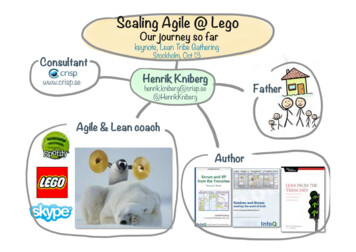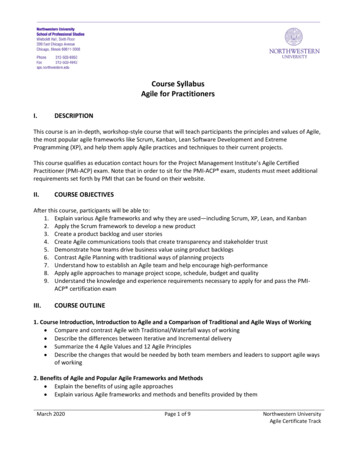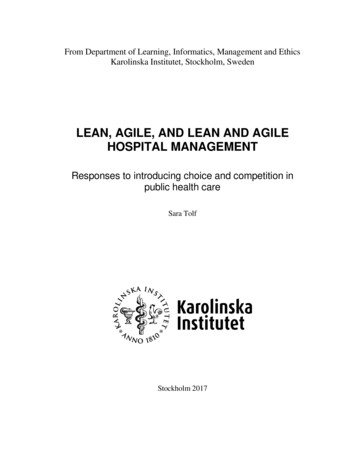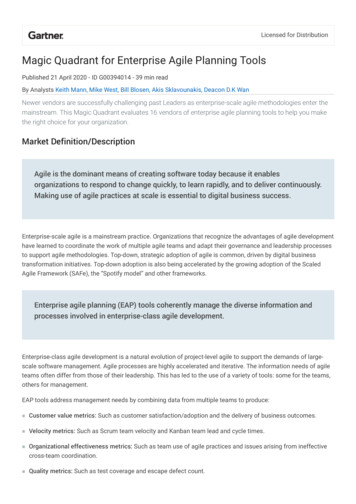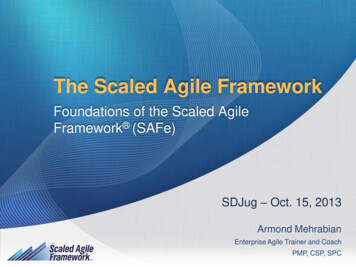
Transcription
Agile ServiceManagementBringing back speed, flexibility andcustomer focus to your IT team
IndexIntroduction31. What is Scrum?2. What is Agile3. What is Agile Service Management?4. Agile Service Management vs. ITIL4912145. Agile Service Management in practice?6. Making your Incident Management more agile7. Making your Service Level Agreements more flexible1825318. Seven most common pitfalls in agile transition9. How to guide your IT department through an agile transition35442
IntroductionAgile is increasingly popular these days.Originated from the Development world,it’s quickly gaining ground in otherdomains. Service Management is notan exception. But what exactly is AgileService Management?In this e-book, I’ll give you answers toquestions like: what’s the differencebetween agile and Scrum? Can I workaccording to ITIL and agile at the sametime? How do I put the agile philosophyin practice? And where do I begin?Using real-life examples, I’ll show youwhat an agile mindset can do for youand your team. And how agile will helpyou improve your service delivery.I would like to thank Gerard Bakker,Steven Happee and Mark van Meursfor their contributions to this e-book —thanks a lot!Enjoy your read,Bas Blanken, IT consultant &Agile Service Management expert3
1. What is agile?Agile is one of today’s most popularbuzzwords. It’s also a widely misusedand misunderstood term. So let’s firstget back to basics: what exactly is agile?4
What is Agile?The birth of agileIn 2001, the softwarebranch introduces the AgileManifesto for SoftwareDevelopment. The manifestocomprises 4 values: Individuals and interactionsover processes and tools Working softwareover comprehensivedocumentation Customer collaborationover contract negotiation Responding to change overfollowing a planThe inventors of agile haveturned these 4 values into12 principles. Theseprinciples are aimed atsoftware development. Theagile mindset is howeverapplicable to all branches.The most important reasonto introduce agile tosoftware development wasto make large organizationsmore flexible. For smallerorganizations, it’s easier torespond quickly and meettheir customers’ demand.These smaller companiesdon’t have a set organizationalstructure. Large companiesare a lot less flexible. Theyoften use a waterfall structurefor projects: a plan ordesign needs to go throughdifferent departments andmanagement layers before itcan be executed. The result?An unwieldy organization.5
What is Agile?What is agile?Agile is a mindset. The idea:if you want to survive asorganization, you need tobe flexible.Let’s compare this agilemindset to a jaguar.A jaguar’s instinct is tosurvive. And to survive heneeds to be dexterous andagile enough to react quicklyto the movements of hisprey. For organizations,it’s just as important to bedexterous, especially nowtechnologies follow eachother in rapid succession.Your organization needs tobe flexible enough to quicklyrespond to new technologiesand the ever-changingdemand of the customer.An infamous example isKodak. The company wasvery successful for a longtime as producer of analoguecameras. When photographywent digital, Kodak wasn’tquick enough to respond.After some failed attempts,Kodak filed for bankruptcyin 2012.6
“ With an agile mindset, youassume that your plans aregoing to change.”7
What is Agile?The gains: bring backfast responses andflexibilityAn agile mindset bringsback flexibility and shorterresponse times to yourorganization. When youwork agile, you strivefor the least amount ofbureaucracy possible. Agilerequires a different type ofemployee as well. In an agileworking environment, youwant employees to shareknowledge, act on creativeideas and come up withsolutions. The initiative is notwith the manager, but withthe professionals.changes to a minimum: youcreate a plan and try to keepto it as much as possible.With an agile mindset, youassume your plans are goingHow does agile work? to change. You’re not going toThere is no manual you canfollow the same plan for twofollow to start working agile. It years. You have a clear goalrequires a cultural shift within in mind, but you can changethe organization. The mostcourse. Agile working meansimportant shift is that yourcontinuous improvements.organization starts embracing Your work is never done.change. In the traditionalwork model, you try to keep8
2. What is Scrum?One of the most popular agileframeworks is Scrum. But what is it?And how does Scrum relate to agile?9
What is Scrum?The birth of ScrumWhat is Scrum?It all starts in 1986. IkujiroNonaka and Hirotaka Takeuchipublish their ‘The NewNew Product DevelopmentGame’ article in the HarvardBusiness Review. In thisarticle, they conclude thathistorically, projects in small,multidisciplinary teams bookthe best results.Scrum is a cost-free frameworkfor software development. Theframework makes it easier fororganizations to develop andmaintain products in complex,dynamic environments.Scrum is an answer to therapidly developing technologyindustry and the fast-changingdemands of customers. Theframework has an empiricalstarting point: you learn bydoing and use your findingsto determine your next step.With this conclusion inmind, Jeff Sutherland andKen Schwaber created adevelopment method forthe software branch in 1996.Scrum was born.How does Scrumwork?Scrum works for small selfmanaging teams of 3 to 9people. A Scrum team worksaccording to a step-by-stepmethod. The team deliversa new or improved product,or a new or improvedfunctionality, within a setperiod of time (two weeks, forexample). These short ‘sprints’force you to constantly workwith realistic deadlines.10
What is Scrum?The gains:transparency,inspection andadaptationWhat’s to gain from dividingyour work into sprints?You plan your work morerealistically. You know whatyou need to do and howmuch time you have forit. This makes for a morepredictable planning ofyour work.Risks are also moremanageable when you usethese shorter periods. You’renot going to make a long-term plan with an extensiverisk analysis. With each stepthe team takes, they showthe organization what hurdlesthey needed to overcome,which scenarios the teamcan follow and what theirimpact is. Based on thisinformation, the organizationcan adjust the course of theteam when needed.The short sprints also ensurethat it’s transparent whatthe team makes. At theend of the sprint you showyour customer what you’vemade. The advantage oftransparency? The customergives regular feedback theteam can take with them inthe next sprint. This ensuresthat the product you makeis something the customer isreally happy about.Want to get started with Scrum?Just follow the rules in the Scrum guide and get started.Get some experience and discover how Scrum works inyour organization.11
3. What is AgileService Management?So, now you know what agile is. Butthe next question arises: what is AgileService Management? The answer issurprisingly simple.12
What is Agile Service Management?Simply put? Agilemanagement is applying theagile mindset to IT ServiceManagement. Nothing more,nothing less.In Chapter 1, I explained whatagile is and which principlesare at thebase of the mindset. The4 values of agile softwaredevelopment just need oneadjustment to apply to ITService Management: I ndividuals and interactionsover processes and tools. Working software servicesover comprehensivedocumentation. C ustomer collaboration overcontract negotiation. R esponding to change overfollowing a plan.delivering services. Soundsstraightforward. And in asense, it is. But how do youapply this in practice? Andhow do these agile principlesrelate to the framework thathas been a golden standardat IT departments fordecades: ITIL?The idea is that youkeep to these principleswhen designing and13
4. Agile ServiceManagement vs. ITILIT is falling deeply in love with agile.But is it possible to have a happymarriage between Agile ServiceManagement and watertight ITIL?14
Agile Service Management vs. ITILIs it possible to pair AgileService Management andITIL? When we compare the4 basic values of the agilemanifesto with ITIL, we’dconclude it’s not possible.At first sight, ITIL seems toattach great importance toeverything the agile mindsetbelieves to be less important:Individuals and interactionsover processes and tools.ITIL implementations atorganizations mostly focuson process descriptions andsystems. The goal is to geta steady quality of services.It shouldn’t matter whosupplies the service.Working servicesover comprehensivedocumentation. ITILoften goes hand in handwith extensive processdocumentation. It took5 books with a total of1,300 pages to explain the26 ITILv3 processes.Customer collaborationover contract negotiation.Laying down contractualagreements and meetingthem is an importantpart of ITIL Service LevelManagement. Making SLAsis one of the main goals formany organizations and it’soften the most importantcriterion for managers orcustomers to judge theIT organization.Responding to change overfollowing a plan. ITIL isabout predictable processes.The idea: if you think out allthe steps in advance andexecute them accordingly,you’ll always have the desiredoutcome. In many cases, thechange management processis watertight and there’sno way to deviate from theoriginal plan.15
“ Agile is about respondingto change. ITIL aboutpredictable processes.”16
Agile Service Management vs. ITILFramework vs.PhilosophySo, agile and ITIL, not exactlya match made in heaven,right? That’s jumping toconclusions. They do seemquite different, but it’s nothard to find a way in whichthey complement each other.Agile is a philosophy. A setof guidelines for your work.Agile principles help youmake decisions in youreveryday work, but theydon’t tell you how tocomplete specific tasks.ITIL is a framework. A collectionof procedures that work inpractice. As opposed to agile,ITIL does describe how to doyour work — in detail.Being agile with ITILIt’s not that difficult toapproach ITIL with an agilemindset. You can implementthe ITIL process IncidentManagement with the agilemindset, for example. Thismeans you pick the bestoption for your organizationfor each part of the setup.The weird thing is that ITILis quite suitable foran adjusted implementation.ITIL does have a reputationfor being rigid andunnecessary complex, butthat was never the startingpoint. The starting pointwasn’t that organizationswould implement eachaspect of ITIL to the letter.The message of ITIL wasalways: make sure to applythis way of working to suityour own organization. Andyour way of implementingITIL could very well be agile.17
5. Agile ServiceManagement inpractice?It turns out agile and Service Managementgo together quite nicely. But how? Howdo you translate the agile philosophy toactual changes in your work? Here are6 examples.18
Agile Service Management in practiceThere is of course much to learn from other organizations. According to the Agile Service Management principlesby Dolf van der Haven, I’ll give you 6 practical examples on how to make your Service Management more agile.1Make sure everything you do adds value for the customerIT departments too often put a lot of work into things that have little value for theircustomers. I recently visited an organization where the IT department had writtenan extensive manual for a new smartphone they offered. Sounds useful, but mostof this information was already available on the internet. And the next OS update isgoing to make their manual outdated.A more agile way of documenting is to keep the information in your manual limitedto what is strictly necessary and first give these instructions to a small test group.Only describe company-specific information, like how to synchronize your workemail with the new smartphone. Do you receive questions from your test group?Update the documentation before you officially start supplying the smartphone.19
Agile Service Management in practice2Always work closely with your customersWhen designing services or processes, service organizations make a lot of assumptionsabout the needs of their customers. An example: for years, a facilities organizationencouraged their customers to log a call when something was wrong in the office building.They recently discovered their customers found it quite annoying to receive five to six statusupdate emails after they logged a call. That was the reason many customers decided to stoplogging calls altogether.In Agile Service Management, you involve your customers often and as soon as possible witheverything you do. This way, you avoid working based on assumptions. The organization fromthe example has come up with a solution together with their customers. When customerslog a call, they can tick a box saying they want to receive status updates. One question and asingle checkbox could have spared five years of frustration.20
Agile Service Management in practice3The right people in the right placeMany IT organizations lean heavily on processes. The goal of working with processes is toguarantee a consistent quality of services, no matter who supplies the service. Sounds goodin theory. In practice, it does matter who supplies the service. An unmotivated service deskemployee probably leaves a less positive impression on the customer than a happy, motivatedemployee. You can’t cover this difference with a process.An important part of the agile mindset is having enough time and attention for your teammembers. Your team only functions well with people who are good at the work they do, andwhen the work they do makes them happy. Is a team member no longer motivated? Talk tohim or her. Maybe they’re happier in a different role.21
Agile Service Management in practice4Make your processes as flexible as possibleITIL processes are usually not flexible. Take change management. A Request for Change needsto go through a set number of predefined steps. The only choice you have in the process isapprove or decline. There is no room to change plans. If you want to change them, you needto stop the process, make a new plan and get approval.Make sure that the processes you design are flexible enough to deal with ever-changingdemands. This however doesn’t mean you need to implement every single change duringthe process. It does mean that you leave room for your team to deal with the processes asthey see fit.22
Agile Service Management in practice5Design, implement and improve your services step by stepNew software or services implementations can take up months, years even. When theimplementation is finally done, you’ve gained so many new insights you probably wantto change everything. But by that time there’s no more budget left, the project teammembers have moved on and it’s up to the application manager to process all thefeedback on her or his own.Delivering new services in an agile way means you deliver something workable as soon aspossible, collect feedback, and use this feedback to improve the product. At TOPdesk wedo software implementations step by step. We first set up a basic version of the IncidentManagement process, and as soon as it’s operational, we go live. The process isn’t perfect,but we’re okay with that. While we continue working on the next process, we receivefeedback to improve Incident Management.23
Agile Service Management in practice6Keep your services and operations straightforwardRequest processes often contain a lot of unnecessary management authorizations.The IT department assumes that management wants control over every individual request.Or the IT department doesn’t carry any responsibility. This makes for a process full ofauthorizations and a manager who gets loads of emails with authorization requests.The process shouldn’t be this cumbersome. It works better when the IT department asksthe managers how much control they really want or need. They usually don’t really wantto receive all those emails. An alternative solution: requests don’t need to be authorized,and the manager receives a monthly overview of the costs. This way, the manager still hascontrol and an overview, but he or she doesn’t have to process a lot of emails. And theemployee is helped quicker.Tip: just get started and keep it smallI sometimes get the question: where do I need to start when I want to work more agile?To be honest, that differs per organization. Take a close look at your current services andcompare this with the agile principles. Where’s the friction? And what improvements areeasy to implement? Start there. Make a small improvement. Ask for feedback. And moveon to the next improvement.24
6. Making yourIncident Managementmore agileIncident Management is the mostimportant process of a supportingdepartment. It’s also quitestraightforward. Is there anything youcan do to make incident resolution moreagile? Yes, you can. I’ll tell you how.25
Making your Incident Management more agileRemove all steps thathave no customer valueAre you thinking of makingyour incident process moreagile? Your first step is to takea critical look at your currentprocess and evaluate eachstep by thinking: does this stepadd value for the customer?To answer this question,you first need to know whatyour customer wants. Yourcustomer probably wantsa quick and good solution.Every step in your incidentmanagement process needsto contribute to how quicklyan incident is processed.Or to offering your customera better solution. Is there astep that doesn’t contributeto your goal? See if you canremove it.You can compare it to the leanapproach. Here, you eliminateeverything wasteful from yourprocess. The difference is,with lean your goal is to makethe process more efficient,and with agile you want toadd as much value as possiblefor the customer.26
Making your Incident Management more agileA traditional incident management processLet’s have a look at a regular incident management process.Question,disruption orrequestA customer logs an incident.A service desk employeeadds information such asclassification and schedulingto this incident. Then, he orshe checks to see if he or shecan process the incident. Ifthe answer is yes, he or sheprocesses it. If the answer isno, the incident is forwardedto a specialist. The specialistmakes the same assessment.When the incident is solved, itis returned to the service desk.There, the incident is closedand the customer is informed.Log incidentClassify &scheduleMe?We?noMe?We?EscalatenoyesLooks quite straightforward,right? Well, it can be even easier.You just need to ask yourself2 questions.Another ?yesInform customer27
Making your Incident Management more agile1. Why does your service desk need toprocess every incident?In many organizations theservice desk closes eachincident, even if the backoffice solved the problem.The back-office specialistdescribes what he’s done, theservice desk translates histechnical story to somethingunderstandable, closes theincident and informs thecustomer. Why? Becausepeople assume that technicalspecialists aren’t strongcommunicators and they can’tdescribe their solution in acustomer-friendly way.This bothers me. If a technicalperson can’t describe hissolution, how does theservice desk know what hedid? A service desk employeeneeds to go through allthe information to piecetogether an understandableexplanation. A waste of time,in my opinion.Why shouldn’t the backoffice be able to writeunderstandable solutions fortheir customers? I understandthat it might be difficult forsome, but it’s easy to learn.Have a training session andcoach each other. It’s a lotmore efficient if the backoffice can describe andclose their own incidents,as opposed to having theservice desk figure out whatto write to the customer.Plus, the incident needs lessforwarding, which makes fora shorter duration.28
Making your Incident Management more agile2. Does your service desk really need tofill out all fields?For each incoming incident,you need to fill out a lotof data. But is this reallynecessary? You only need toknow a few things to processan incident. The caller, thequestion and a deadline forthe call. The rest of the data isonly used for reports.Go through all filled-out datawith the service desk andmanagement to determine ifyou really need it for reports:Are there reports forthis data?I’ve visited dozens oforganizations where theservice desk filled out allkinds of fields, but they neverended up in a report. Howdoes this happen? Duringthe implementation, somepeople might have thought:‘Let’s fill out these fields, thenwe can report on them later’.However, the reports werenever made.Does someone readthese reports?What also happens: thereare reports on certain data,but no one reads them.I once visited an organizationwhere the IT department sentmonthly incident reports tomanagement. They suspectedno one read the reports,because they never got areply to their emails. That’swhy they added the sentence‘Whoever reads this can29
Making your Incident Management more agilecome and get a pie at the ITdepartment’ on the secondpage of the report. Guesswhat? No reaction. Aftera couple of months, theycompletely stopped sendingthe report. No one ever askedwhat happened to it.make improvements basedon these reports? Do theseimprovements help contributeto your overall goal: find asuitable solution for yourcustomer as fast as possible?If so, are these improvementsimportant enough to fill out allthis data for each incident?What happens with thereports?Imagine there are reports onall the data you filled out, andthat these reports are read.Then the question arises: dowe actually do something withthis data? Does managementDon’t get me wrong. I’m notsaying reports are useless. Onthe contrary, reports can givevaluable information aboutyour Service Managementprocess. But you need tostay critical. Is some data notrelevant? Don’t fill out thefields, or have them filledautomatically. This savesthe service desk a lot ofregistration time.30
7. Making your ServiceLevel Agreementsmore flexibleWhile SLAs are great for reporting tomanagement, relying on them tooheavily will risk long-term damage toyour organization. You get blinded bynumbers and forget about the service.The solution? A shift towards XLAs.31
Making your Service Level Agreements more flexibleWhat is an XLA?If your Service Desk was afruit, what would it be? Anapple? An orange maybe? Trya watermelon. It may soundridiculous, but humor me fora second! The WatermelonService Desk was first used byMarco Gianotten of Giarte foran SLA-focused Service Desk.The dashboards are greenand management is thrilled.Yet underneath simmer redwarning signs of resentmentand dissatisfaction.A 5 minute average responsetime and 8 hour closure ratesounds fantastic. But SLAstats miss something: theexperience of the user. Notdelving beneath the shinygreen exterior could becausing your business harm.The value of XLAsXLA is a concept developedby Giarte and the X standsfor eXperience. It means thatperformance is dictated bythe one person who feels itthe most: the customer. Thegood thing is that generally,you need less XLAs thanSLAs to give an indication ofperformance, which makesthem easier to manage.If you are planning to adopta more agile way of working,then XLAs will complimentthis perfectly. XLAs naturallyfocus on interactions andcustomer collaborationrather than cumbersomecontractual obligations. TheXLA is also very susceptibleto change. When the needsand requirements of yourcustomer change, your XLAsadapt too.32
“ Your service desk SLAsare like a watermelon.”33
Making your Service Level Agreements more flexibleWhere do I start?There are hundreds ofmethodologies to measurecustomer experience. Startout by keeping it simpleand using a single questionto capture the customersexperience when a call isclosed. Star ratings are auseful one-click responsethat already give you insightsinto the services previouslyunseen by traditional SLAs.But there is more to it thanmetrics. XLAs represent achange in culture by shiftingthe focus from performanceto the experience of thecustomer. You have to getyour operators on boardthrough persona creationand mapping the customerjourney. Over time you willnotice an interesting shift;you might start missingthe odd SLA target, yetyour customer experiencecontinually improves. Thequestion is raised: what arewe using all these SLAs for?Streamlining yourservicesIf you have left some of yourheavy SLAs behind and youfind yourself with a few simpleXLAs that keep your customershappy, you will find yourselfless like a watermelon andmore like a grape: bite-size,and green both inside and out.34
8. Seven mostcommon pitfalls inagile transitionConsidering shifting to an agile workenvironment? There’s no script youcan follow. However, there are expertswho can help smooth the transition.Steven Happee is one of them.35
Seven most common pitfalls in agile transitionSteven Happee’s love for agile blossomed in the nineties, when he developed software in asmall, multi-disciplinary team, in a way that would now be called agile: a lot of contact withcustomers, quick value delivery, and transparent work processes.Now, twenty years later, he helps organizations make the transition to become moreagile and learning-oriented. He uses his extensive experience as product owner,Scrum master, developer and manager to conduct valuable experiments. Based on hisexperience, Steven shares the 7 most common pitfalls for agile transitions.36
Seven most common pitfalls in agile transition1Only look at the agile transition top-downYou can approach agile transformations in two ways: top-down and bottom-up. A bottomup approach means the team takes initiative, often in IT, to implement a more agile way ofworking with a single team.For top-down, the initiative comes from the manager, CEO or CIO and the goal is often tomake a large part or even the entire organization more agile. The top-down approach isrelatively new. These past few years, agile has become a hot topic and more and more CEOsand CIOs are thinking: ‘Should we do something with agility?’ A good idea, but it doesn’t workif the organization isn’t with them.A bottom-up approach is usually more successful. This is something you see in IT teams,where the agile mindset comes from originally. Someone in the team wants to experimentwith agile, his manager is enthusiastic and a scrum team is formed. When this team performswell, more teams might follow and the organization becomes curious.An approach that combines bottom-up and top-down works best: a team takes the initiativeto implement a more agile way of working and finds a sponsor at the top of the organization.37
Seven most common pitfalls in agile transition2Using the waterfall method for your agile transitionTen years ago, there were a lot of people who believed that you needed to use Prince2 for anagile transition. First you make a design, implement it step by step, create milestones, etcetera.This a paradox of course.Fortunately, most people these days are convinced that an agile transition needs an agileapproach. The transition to agile is a complex project after all — meta-agile as you may callit. People start to work differently together, your way of working changes and your tools aredifferent. It’s best to have an iterative transition with a multi-disciplinary team and a changebacklog. An added bonus is that you set the right example.38
Seven most common pitfalls in agile transition3Being too strict with agile techniquesAgile frameworks like Scrum offer techniques to apply an agile mindset to your daily work.A backlog, retros — they’re all very visible. But these techniques are just the tip of the iceberg.It’s the visible aspect of agile working. They are based on certain assumptions on how toorganize your work, and these assumptions fall back on principles from the Agile Manifestoor Modern Agile.Some people have the tendency to be very strict with these agile techniques, but withoutunderstanding the underlying principles. That can cause friction. Some techniques mightnot work for your organization, so it would be a shame to follow them religiously. In the end,you need to embrace the agile values, not the techniques. That’s why it’s good to explain theunderlying principles to someone who wants to do something with agility, so they can fallback on them.39
“ An agile transformationimpacts all processes andpeople in your organization.”40
Seven most common pitfalls in agile transition4Creating variations on existing techniques too quicklyYes, you need to make agile techniques your own. But not from the very start. The agile worldoften refers to ShuHaRi, a Japanese martial art concept on how to make something yourown in 3 phases. You start by strictly following the existing technique (Shu). When you’veinternalized the rules, you can make variations (Ha), until you reach Ri: you’re subconsciouslycompetent and there is no longer a need for rules or techniques.You often see that teams start varying on existing techniques, or collect elements fromdifferent frameworks: cherry picking. You hear a lot of excuses for this: ‘I know the theoryand I know it’s not going to work for us’ or ‘We like to experiment, so we’re combining somedifferent techniques’. It’s good to experiment, but make sure to vary from a solid foundation.Work with an existing method for six months or one year and experience what it’s like. Howdo sprints work? What is a good retro? How do we formulate customer value? Only when yourfoundation is solid, you can start varying.41
Seven most common pitfalls in agile transition56People working in an agile and project teamAgile working and project-based work have fundamentally different starting points. For agile youhave the same teams, with team members who know each other’s strengths and keep evolvingtogether. You give the teams work. With project-based work you
ITIL is a framework. A collection of procedures that work in practice. As opposed to agile, ITIL does describe how to do your work — in detail. Being agile with ITIL It’s not that difficult to approach ITIL with an agile mindset. You can implement the ITIL process Incident Management wit





